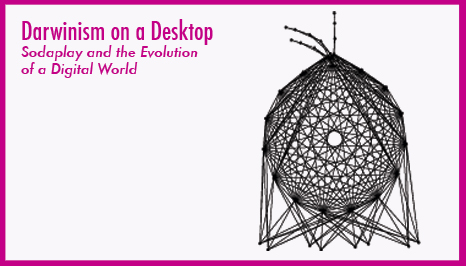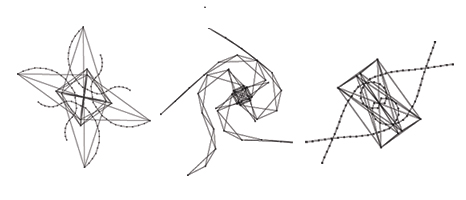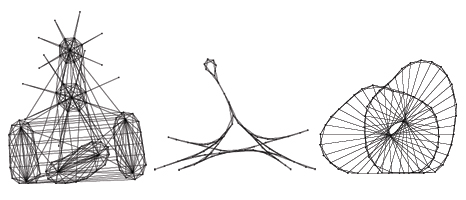 |
|
|||
Click here to view all Upcoming Events// IFF Directors Talks
IFF Directors Talks 2012 // Previous IFF Lectures THE MOSELY SNOWFLAKE SPONGE THE ART OF ITERATION MAKING SPACE IFF Director Margaret Wertheim speaks at Art Center College of Design Captain Charles Moore Talks About Plastic Trash IFF Director Margaret Wertheim Seeing Anew [IFF-L20] Structural Considerations of the Business Card
Sponge[IFF-L17] Where the Wild Things Are 2: Things That Think: Where the Wild Things Are: Crocheting the Hyperbolic Plane: Darwinism on a Desktop: The Logic Alphabet Why Things Don't Fall Down Kindergarten: Crocheting the Hyperbolic Plane [IFF-L5] The Mathematics of Paper Folding [IFF-L4] The Physics of Snowflakes [IFF-L3] Crocheting the Hyperbolic Plane [IFF-L2] The Figure That Stands Behind Figures: // Previous Events Crochet Hyperbolic Workshop
|
The
fourth in our 2005 lecture series Friday, July 29 @ 7:30 pm |
|||
 |
||||
|
They crawl, they hop, they slink and they undulate. Some roll, some fly and others unfold into complex forms from a simple triangle. These “creatures” are the products of an extraordinary evolutionary experiment that now involves more than 100,000 people worldwide. Each of these forms has been created through a program called the sodaconstructor that enables users to build models that increasingly resemble living organisms. Over the past five years a global community has brought forth from this digital mud a Cambrian explosion of species: walkers, stalkers, floaters and flyers; things that tumble and skip; simulations of spiders, crabs and starfish; monopeds, bipeds, tripeds and centipeds; self-propelling squares, and a mobius strip that turns itself inside out. This imaginary Galapagos resides on a server in the Shoreditch area of London’s east end in the office of Soda Creative, an innovative company that specializes in producing software at the boundary of art and education. (www.sodaplay.com) |
||||
 |
||||
| The architect of this online world is Ed Burton, an artist and computer programmer. Burton designed his soda-software as a virtual toy based around the principles of the engineering discipline known as Control and Dynamic Systems. Each model is made up from a set of points and lines: some of the lines are simple springs and act as a kind of soft skeleton; others act like muscles and can change length. In effect, the structures may be seen as virtual tensegrities. By connecting points in various arrangements of lines, structures can be given an internal logic that causes them to move. From these simple beginnings sodaplay users have evolved ever more complex mechanisms that can now mimic such sophisticated tasks as bipedal walking and multi-wheeled rolling. In this talk Burton will discuss the evolution of the sodaplay universe and the processes by which the community of soda constructors collectively develop new styles of form and function within this software world. | ||||
|
||||
| All images courtesy of Soda Creative | ||||
| Ed Burton is R&D director for Soda Creative. (www.sodaplay.com). He is a graduate of the Center for Electronic Arts at Middlesex University where, for his master’s thesis, he wrote a graphics program called ROSE (Representation Of Spatial Experience) that simulates children’s drawings. Given a three-dimensional model of a horse or a house, ROSE outputs its own rendition of a juvenile sketch. Burton is currently working on a new version of this software that learns from its previous experience. When designing his sodaconstructor program for building virtual engineering models, Burton was inspired by computer pioneer Seymour Papert’s constructivist notion of “creative play.” In the next iteration of the software, users will be given the power to make up their own sodaplay rules. | ||||
 |
||||
| These three structures by esteemed soda-constructor, Kevino | ||||
In addition to Burton, we will also be joined by Kevin Okada, aka Kevino, one of the most innovative and imaginative soda-constructors. Kevino is the architect of some of the most enigmatic soda-models, including Inspyre, (pictured in the middle above). Calling to mind a balletic octopus, Inspyre is driven by a central "motor" comprised of two square cogs rotating in opposite directions. To this central drive mechanism, four tentacle-like fronds have been appended, their graceful undulations imparting to the whole an undeniably organic quality. Kevino has also been one of the innovators of a sodaplay mechanism known as "pre-tensioned flex linkages" or "flex chains," a technology he has exploited to make models that resemble psychaedelic jellyfish and hypnotic mechanical butterflies (also above). A gallery of his models can be seen online at the website of the UK's National Endowment for Science, Technology and the Arts: www.nesta.org.uk/inspireme/ soda/sodaplay.htm. Offline, Okada is a resident of the San Fernando Valley who works for the Aussie Racing Apparel company. As a child he was obsessed with Tinkertoy constructions and once built a working physical model of a digging machine out of Tinkertoy parts, driven by the motor from a discarded cassette player. An interactive sodaplay exhibit will be on display at Telic during the evening. For documantation of the lecture, please look at the photo gallery. |
||||
| © 2003–2018 The Institute For Figuring | ||||
